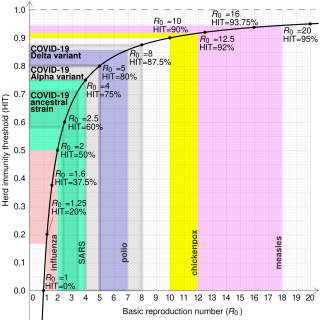
Exponential growth is a process that increases quantity over time at an ever-increasing rate. It occurs when the instantaneous rate of change of a quantity with respect to time is proportional to the quantity itself. Described as a function, a quantity undergoing exponential growth is an exponential function of time, that is, the variable representing time is the exponent. Exponential growth is the inverse of logarithmic growth.
Viral marketing is a business strategy that uses existing social networks to promote a product mainly on various social media platforms. Its name refers to how consumers spread information about a product with other people, much in the same way that a virus spreads from one person to another. It can be delivered by word of mouth, or enhanced by the network effects of the Internet and mobile networks.

In epidemiology, the basic reproduction number, or basic reproductive number, denoted , of an infection is the expected number of cases directly generated by one case in a population where all individuals are susceptible to infection. The definition assumes that no other individuals are infected or immunized. Some definitions, such as that of the Australian Department of Health, add the absence of "any deliberate intervention in disease transmission". The basic reproduction number is not necessarily the same as the effective reproduction number , which is the number of cases generated in the current state of a population, which does not have to be the uninfected state. is a dimensionless number and not a time rate, which would have units of time−1, or units of time like doubling time.
Mathematical models can project how infectious diseases progress to show the likely outcome of an epidemic and help inform public health and plant health interventions. Models use basic assumptions or collected statistics along with mathematics to find parameters for various infectious diseases and use those parameters to calculate the effects of different interventions, like mass vaccination programs. The modelling can help decide which intervention(s) to avoid and which to trial, or can predict future growth patterns, etc.
Mobile marketing is a multi-channel online marketing technique focused at reaching a specific audience on their smartphones, feature phones, tablets, or any other related devices through websites, e-mail, SMS and MMS, social media, or mobile applications. Mobile marketing can provide customers with time and location sensitive, personalized information that promotes goods, services, appointment reminders and ideas. In a more theoretical manner, academic Andreas Kaplan defines mobile marketing as "any marketing activity conducted through a ubiquitous network to which consumers are constantly connected using a personal mobile device".
Social media optimization (SMO) is the use of a number of outlets and communities to generate publicity to increase the awareness of a product, service brand or event. Types of social media involved include RSS feeds, social news, bookmarking sites, and social networking sites such as Facebook, Instagram, Twitter, video sharing websites, and blogging sites. SMO is similar to search engine optimization (SEO) in that the goal is to generate web traffic and increase awareness for a website. SMO's focal point is on gaining organic links to social media content. In contrast, SEO's core is about reaching the top of the search engine hierarchy. In general, social media optimization refers to optimizing a website and its content to encourage more users to use and share links to the website across social media and networking sites.
Engagement marketing, sometimes called "experiential marketing", "event marketing", "on-ground marketing", "live marketing", "participation marketing", "Loyalty Marketing", or "special events", is a marketing strategy that directly engages consumers and invites and encourages them to participate in the evolution of a brand or a brand experience. Rather than looking at consumers as passive receivers of messages, engagement marketers believe that consumers should be actively involved in the production and co-creation of marketing programs, developing a relationship with the brand.
Flixster was an American social-networking movie website for discovering new movies, learning about movies, and meeting others with similar tastes in movies, currently owned by parent company Fandango. The formerly independent site, allows users to view movie trailers as well as learn about new and upcoming movies at the box office. It was originally based in San Francisco, California and was founded by Joe Greenstein and Saran Chari on January 20, 2006. It was also the former parent company of Rotten Tomatoes from January 2010 to February 17, 2016. On February 17, 2016, Flixster, including Rotten Tomatoes, was acquired by Fandango.

Digital marketing is the component of marketing that uses the Internet and online-based digital technologies such as desktop computers, mobile phones, and other digital media and platforms to promote products and services. Its development during the 1990s and 2000s changed the way brands and businesses use technology for marketing. As digital platforms became increasingly incorporated into marketing plans and everyday life, and as people increasingly used digital devices instead of visiting physical shops, digital marketing campaigns have become prevalent, employing combinations of search engine optimization (SEO), search engine marketing (SEM), content marketing, influencer marketing, content automation, campaign marketing, data-driven marketing, e-commerce marketing, social media marketing, social media optimization, e-mail direct marketing, display advertising, e-books, and optical disks and games have become commonplace. Digital marketing extends to non-Internet channels that provide digital media, such as television, mobile phones, callbacks, and on-hold mobile ringtones. The extension to non-Internet channels differentiates digital marketing from online marketing.
Customer engagement is an interaction between an external consumer/customer and an organization through various online or offline channels. According to Hollebeek, Srivastava and Chen S-D logic-Definition of customer engagement is "a customer’s motivationally driven, volitional investment of operant resources, and operand resources into brand interactions," which applies to online and offline engagement.
Referraleconomy is a system where people help and trust each other by sharing their experiences about a product. The keystone of its function is confidence: "92% of respondents trusted referrals from people they knew" - Nielsen. This normally happens among friends, which enhances the value of the recommendation, since there are no trade interests.

Content marketing is a form of marketing focused on creating, publishing, and distributing content for a targeted audience online. It is often used by businesses in order to achieve the following goals: attract attention and generate leads, expand their customer base, generate or increase online sales, increase brand awareness or credibility, and engage an online community of users. Content marketing attracts new customers by creating and sharing valuable free content as well as helps companies create sustainable brand loyalty, provides valuable information to consumers, and creates a willingness to purchase products from the company in the future.
Social network advertising, also known as "social media targeting," is a group of terms that are used to describe forms of online advertising and digital marketing that focus on social networking services. One of the significant benefits of this type of advertising is that advertisers can take advantage of the users' demographic information, psychographics and other data points to target their ads appropriately.

Social media marketing is the use of social media platforms and websites to promote a product or service. Although the terms e-marketing and digital marketing are still dominant in academia, social media marketing is becoming more popular for both practitioners and researchers. Most social media platforms have built-in data analytics tools, enabling companies to track the progress, success, and engagement of ad campaigns. Companies address a range of stakeholders through social media marketing, including current and potential customers, current and potential employees, journalists, bloggers, and the general public. On a strategic level, social media marketing includes the management of a marketing campaign, governance, setting the scope and the establishment of a firm's desired social media "culture" and "tone."

Active users is a software performance metric that is commonly used to measure the level of engagement for a particular software product or object, by quantifying the number of active interactions from users or visitors within a relevant range of time.
In marketing, attribution, also known as multi-touch attribution, is the identification of a set of user actions that contribute to a desired outcome, and then the assignment of a value to each of these events. Marketing attribution provides a level of understanding of what combination of events in what particular order influence individuals to engage in a desired behavior, typically referred to as a conversion.
Growth hacking is a subfield of marketing focused on the rapid growth of a company. It is referred to as both a process and a set of cross-disciplinary (digital) skills. The goal is to regularly conduct experiments, which can include A/B testing, that will lead to improving the customer journey, and replicate and scale the ideas that work and modify or abandon the ones that do not, before investing a lot of resources. It started in relation to early-stage startups that need rapid growth within a short time on tight budgets, and also reached bigger corporate companies.
Viral phenomena or viral sensation are objects or patterns that are able to replicate themselves or convert other objects into copies of themselves when these objects are exposed to them. Analogous to the way in which viruses propagate, the term viral pertains to a video, image, or written content spreading to numerous online users within a short time period. This concept has become a common way to describe how thoughts, information, and trends move into and through a human population.
Social media reach is a media analytics metric that refers to the number of users who have come across a particular content on a social platform such as Facebook, Instagram or Twitter. Social media platforms including Facebook, Twitter, YouTube, Instagram, Spotify and many more have their own individual ways of tracking, analyzing and reporting the traffic on each of the individual platforms. Each platform allows their users, from everyday citizens to public figures and companies, to create posts and content, to be active on the platform and to interact with other users. These platforms are also a main source of communication between companies and their target audiences. By conducting research, companies are able to utilize analytical information, such as the reach of their posts, to better understand the interactions between the users and their content.

Spotify Wrapped is a viral marketing campaign by Spotify. Released annually since 2016, every early December, the campaign allows Spotify users to view a compilation of data about their activity on the platform over the past year and invites them to share it on social media.











